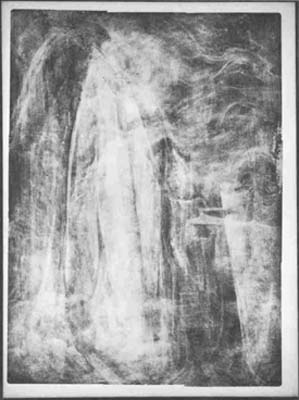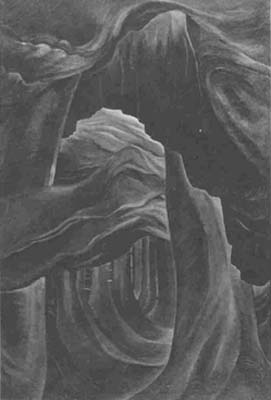
Bulletin 25, 1975
Home
Français
Introduction
History
Annual Index
Author &
Subject
Credits
Contact



Emily
Carr's "Blunden Harbour'
by Maria Tippett
Résumé en français
Pages 1 | 2
In his book Victorian
Painters, Jeremy Maas states that no other invention ever
rendered painting such a service as photography. (1) On various
occasions Millais, Rossetti, and other Victorian artists made
practical use of the camera. After the discovery of Tanagra in the
1870s, Whistler was able to accurately reproduce the Hellenestic
terracotta statuettes and other objects of classical antiquity from
an album of photographs. (2) Photography has also been a source of
inspiration for Canadian artists. Peter Mellen has noted that the
use of a photograph did not detract from Varley's The Sunken Road, but enabled him "to go beyond the photograph to make
a powerful statement about the war." (3) A borrowed photograph
(fig. I) of British Columbia's Blunden Harbour allowed Emily Carr to
portray a native village (fig. 2) where her travels had never taken
her.
Blunden Harbour is a small remote Kwakiutl village on a bay in Queen
Charlotte Strait. In 1901, Dr Charles Frederick Newcombe, a
distinguished anthropologist who had been closely associated with
the Provincial Museum in Victoria since 1889, visited and
photographed the village. His son, William Arnold, Who was a
long-time friend of Emily Carr, "gave her valuable information
and loaned her his father's unique photographs." (4) Among these
was the 1901 photograph of Blunden Harbour. On the reverse side of
Newcombe's Copy is the testimony that "a 4 x 5 negative was
loaned to Miss Emily Carr about 1930 by W. A. Newcombe." The
inscription continues that "Miss Carr painted Blunden
Harbour, now in the National Gallery, Ottawa from it - never
having had an opportunity of visiting this village personally."
(5)
Carr had begun to take her own photographs in 1912 on her excursion
to the Queen Charlotte Islands and the Nass and Skeena Rivers. Kwakiutl
House (Vancouver Art Gallery) was painted with the aid of a
watercolour sketch, Tsatsinuchomi (Vancouver Art Gallery),
and a photograph taken in that village in 1912. (6) After Carr's
"discovery" in 1927, material to paint from did not
become any more plentiful than before, though access to Newcombe's
photographs allowed her to supplement her small collection.
Blunden Harbour's exhibition in the National Gallery's
Canadian Annual of 1933 saw it shipped from Victoria in the fall of
1932. The painting was, therefore, rendered between 1927, when her
style changed radically, and late 1932, when it was submitted for
exhibition.
Blunden Harbour was X-rayed (fig. 3) by the Restoration and
Conservation Laboratory of The National Gallery of Canada. The
result, here reproduced, shows an entirely different painting
beneath. What appears to be giant cedar rendered in the style of Forest,
B. C. (fig. 4) (Vancouver Art Gallery), c. 1930, has been
overpainted by the Indian motif disqualifying the possibility that
Blunden Harbour could have been painted prior to 1930. (7) This
new evidence coupled with Newcombe's testimony that the photograph was loaned to "Miss Carr about 1930" means that she
painted it between the fall of 1930 and the winter of 1931. Any
later date would be unlikely, as the spring of 1931 saw Carr shift
completely to forest subjects. She did not return to the Indian
theme until the early 1940s.
Carr was often hard-pressed for material from which to paint. Though
she travelled north during the summer of 1928 and gathered
"quite a bunch of work" (8) it was not sufficient. Paintings
from the 1927 Indian and West Coast exhibition, still held by the
National Gallery were requested from the gallery's director:
"Please Mr Brown...may my watelcolours be sent home to me as
soon as possible - I want some of them to work from...." (9)
Carr was
again strapped in the autumn of 1930. She had been asked by the
Seattle Art Institute to stage a solo exhibition in late November.
(10) By mid-November she was still working very hard in order to
prepare thirty-two canvases for the Seattle show. (11) Even after her
preparation of the Seattle show, she continued to find material
where she could. Big Raven (Vancouver Art Gallery) was
painted from the 1912 watercolour of Cumshewa (National
Gallery of Canada) and Zunoqua of the Cat Village (Vancouver
Art Gallery) from the sketch Koskimo (Vancouver Art Gallery)
made in Fort Rupert in 1929. (12)
Carr, who was turning more to the forest this winter of 1930-1931,
had her last fling at the Indian motif for a decade. It was then
that she borrowed Willie Newcombe's photograph and, painting over
a tree, created her powerful canvas.
The painting is almost identical in composition to the photograph
here reproduced. Characteristic of her post-1927 work is the
elimination of native figures. The logs in the water and the
deciduous trees behind the buildings have also been omitted. The
absence of these details, as well as the addition of the clouds and
the light coming from behind the work, gives the painting a highly
dramatic aura. By her simplification, stylization, and omission,
she has surpassed the undifferentiated details of the camera's lens.
Shown at the Canadian Annual, National Gallery of Canada, in
January 1933; the Croup Exhibition, Library of the
University of British Columbia, in February 1935; and the Folk
Show, Hotel Vancouver, in November 1936, Blunden Harbour came
to rest in 1937 when the National Gallery of Canada purchased the
work, which has been called by R. H. Hubbard the most monumental of
her post-1927 period and H. Mortimer-Lamb considered the best
example of "her greatest period of high achievement." (13)
Next Page | Notes
1 |
2
Annual Index | Author & Subject | Credits | Contact
This digital collection
was produced under contract to Canada's Digital Collections program,
Industry Canada.
"Digital
Collections Program, Copyright
© National Gallery of
Canada 2001"